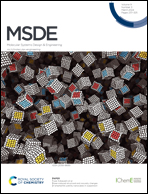A quantum chemical assessment on the sensing ability of porphyrins and phthalocyanines towards volatile organic compounds using density functional theory investigations†
Abstract
In this work, we have investigated the sensing ability of four organic semiconductors namely, H2TPPCOOH and ZnTPPCOOH porphyrins, H2Pc and FePc phthalocyanines for the detection of 16 different volatile organic compounds (VOCs) through first-principles density functional theory (DFT) calculations. We have calculated various electronic properties of VOCs and organic molecules such as HOMO–LUMO, dipole moment, and global reactivity descriptors. The reactivity of VOCs mainly depends on the LUMO and the orbital energy gap. Similarly, the prime descriptors that are needed for understanding the organic molecules are softness, electrophilicity, and HOMO values. Most of the VOCs are physisorbed on the organic molecules. Few VOCs like ammonia (−1.42 eV) and acetonitrile (−1.21 eV) are chemisorbed on FePc with strong adsorption energies. H2Pc has better adsorption to diethylene glycol (−0.24 eV). H2TPPCOOH and ZnTPPCOOH show good binding affinity towards ammonia (−0.42 and −0.50 eV). Furthermore, the chemiresistive sensing properties of the sensors have revealed that H2Pc is sensitive and selective towards diethylene glycol, a potential pollutant that causes renal failure. FePc is sensitive towards all 16 VOCs and hence, it can be used as a universal sensor. Also, it can be used as a single-time sensor due to its strong chemisorption towards VOCs. H2TPPCOOH is highly sensitive to triethylamine and ZnTPPCOOH has high sensitivity to ammonia. Both triethylamine and ammonia cause severe respiratory diseases. Being a powerful tool, the DFT investigations have yielded results that are well-matched with the previously reported experimental works. In summary, we believe that our computational investigations will be useful to build sensor devices composed of highly sensitive and selective porphyrins and phthalocyanines for sensing VOCs from various sources in and around us.



 Please wait while we load your content...
Please wait while we load your content...